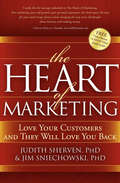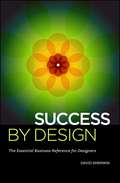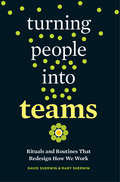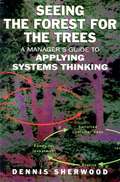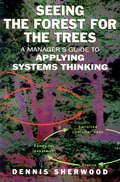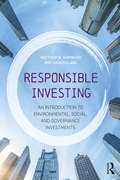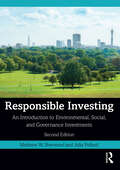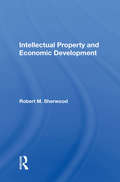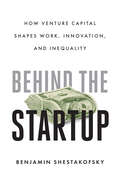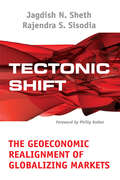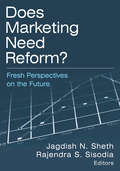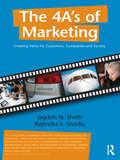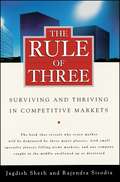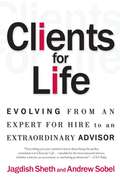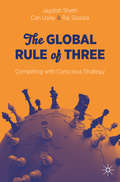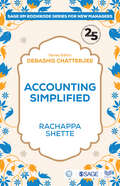- Table View
- List View
The Heart of Marketing: Love Your Customers and They Will Love You Back
by Judith Sherven Jim SniechowskiThis book is about marketing. But more important, this is a book about you, the soft sell marketer--your desire, as a service provider or care-giver, to market and sell your products and services online or off without compromising your personal or professional values. In short, it's about putting your heart into marketing. This book: Validates the power of heart-to-heart connections that lead to emotional authenticity and marketing believability, taking sales beyond mere commercial transactions into long-term customer relationships; presents the principle that Selling Is Spiritual Service, healing the split soft sell marketers often feel between spirituality and sales; sheds light on the internal aspects of marketing beginning with integrity and ending with a balance between commerce and conscience; and will open and inspire your soft sell imagination, setting the foundation for you to understand and profit from the practice of soft sell marketing.
Success By Design: The Essential Business Reference for Designers
by David SherwinWant to make your design business a success? Start here.Fellow Designer,In your career you may have been like me: Trying to keep projects on the rails and clients happy. Digging through blogs for useful advice. Wondering if there was a better way to handle all of the demands of being a design professional and running a creative business.The wisdom contained in Success By Design: The Essential Business Reference for Designers will help you become a stronger businessperson and better plan your career path as a design leader. This book was born from in-depth interviews with a slew of successful designers, studio directors, project managers, and client service professionals across a wide range of creative industries.It contains the business secrets I needed the most when I started as a designer sixteen years ago.--David
Turning People into Teams: Rituals and Routines That Redesign How We Work
by David And SherwinCollaborative strategies work when they're designed by teams—where each person is heard, valued, and held accountable. This book is a practical guide for project team leaders and individual contributors who want their teams to play by a better set of rules.Today's teams want more alignment among their members, better decision-making processes, and a greater sense of ownership over their work. This can be easy, even fun, if you have the right rituals.Rituals are group activities during which people go through a series of behaviors in a specific order. They give teams the ability to create a collective point of view and reshape the processes that affect their day-to-day work. In Turning People into Teams, you'll find dozens of practical rituals for finding a common purpose at the beginning of a project, getting unstuck when you hit bottlenecks or brick walls, and wrapping things up at the end and moving on to new teams.Customizable for any industry, work situation, or organizational philosophy, these rituals have been used internationally by many for-profit and not-for-profit organizations. By implementing just a few of these rituals, a team can capture the strengths of each individual for incredible results, making choices together that matter.
Seeing the Forest for the Trees: A Manager's Guide to Applying Systems Thinking
by Dennis SherwoodSystems thinking can help you tame the complexity of real-world problems by providing a structured way of balancing a broad, overall view with the selection of the right level of detail, truly allowing you to "see the forest for the trees". Only by taking a broad view can we avoid the twin dangers of a silo mentality-in which a fix 'here' simply shifts the problem to 'there'-and organisational myopia-in which a fix 'now' gives rise to a much bigger problem to fix 'then'. Seeing the Forest for the Trees will give you all the tools and techniques you need, with many practical examples as diverse as managing a busy back office, negotiating an outsourcing deal and formulating business strategy.
Seeing the Forest for the Trees: A Manager's Guide to Applying Systems Thinking
by Dennis SherwoodSystems thinking can help you tame the complexity of real-world problems by providing a structured way of balancing a broad, overall view with the selection of the right level of detail, truly allowing you to "see the forest for the trees". Only by taking a broad view can we avoid the twin dangers of a silo mentality-in which a fix 'here' simply shifts the problem to 'there', and organisational myopia-in which a fix 'now' gives rise to a much bigger problem to fix 'then'. Seeing the Forest for the Trees will give you all the tools and techniques you need, with many practical examples as diverse as managing a busy back office, negotiating an outsourcing deal and formulating business strategy.
Seeing the Forest for the Trees
by Dennis SherwoodReaders learn to tame the complexity of real-world problems by using a structured approach of balancing broad views and relevant details. Managers will gain tips and advice on everything from dealing with a busy office to negotiating an outsourcing deal.
Strategic Thinking Illustrated: Strategy Made Visual Using Systems Thinking
by Dennis SherwoodThis book is about the behaviour of systems. Systems are important, for we interact with them all the time, and many of the actions we take are influenced by a system – for example, the system of performance measures in an organisation influences, often very strongly, how individuals within that organisation behave. Furthermore, sometimes we are involved in the design of systems, as is any manager contributing to the definition of what those performance measures might be. That manager will want to ensure that all the proposed performance measures will drive the ‘right’ behaviours rather than (inadvertently) encouraging dysfunctional ‘game playing’, and so anticipating how the performance measurement system will work in practice is a vital part of a wise design process. Some of the systems with which we interact are local, such as your organisation’s performance measurement system. Some systems, however, are distant, but nonetheless very real, such as the healthcare system, the education system, the legal system and the climate system. Systems, therefore, exist on all scales, from the local to the global. And all systems are complex, some hugely so. That’s why understanding how systems behave can be very helpful. Systems are complex for two main reasons. First, the manner in which they behave over time can be very hard to anticipate – and anticipating the future sensibly is of course a key objective of management. Second, the ‘entities’ within a system can be connected together in very complex ways, so that an intervention ‘here’ can result in an effect ‘there’, perhaps a long time afterward. Sometimes this can be surprising, and so we talk of ‘unintended consequences’ – but this is of course a euphemism for ‘because I didn’t understand how this system behaves, I had not anticipated that’. Systems thinking, the subject matter of this book, is the disciplined study of systems, and causal loop diagrams – the ‘pictures’ of this ‘picture book’ – are a very insightful way to represent the connectedness of the entities from which any system is composed, so taming that system’s complexity.
Responsible Investing: An Introduction to Environmental, Social, and Governance Investments
by Matthew W. Sherwood Julia PollardThis textbook provides the first holistic resource on Environmental, Social, and Governance (ESG) investing for undergraduate and graduate programs. It provides a thorough background and history of ESG investing, as well as cutting-edge industry developments, in a way that introduces the reader to the rapidly developing field of responsible investing. Beginning with a comprehensive background of ESG investing and the development of models measuring risk and return, the book then discusses the development of ESG risks, and provides an overview of ESG rating systems. The textbook also outlines the current position of ESG investing in portfolio management through granular analysis, provides insight into common investor concerns about ESG investments, discloses qualitative theories relevant to ESG investing, and reviews literature attempting to model ESG investment performance. Finally, the authors provide readers with a foundation on the development of financial models measuring risk and return, which will be useful for measuring the performance of ESG investments. With case studies from contributors around the world, this textbook is the first of its kind to truly provide a compelling blend of quantitative and qualitative analysis supporting the incorporation of ESG investment strategies into investment portfolios. Offering an excellent overview of the growing trends in ESG investing, as well as a close analysis of ESG theories and their practical application both today and in the future, this book will be a great resource for both undergraduates and graduate students.
Responsible Investing: An Introduction to Environmental, Social, and Governance Investments
by Matthew W. Sherwood Julia PollardResponsible Investing serves as a holistic resource on Environmental, Social, and Governance (ESG) investing for undergraduate and graduate programs. It provides a thorough background and history of ESG investing, as well as cutting-edge industry developments, introducing the reader to the rapidly evolving field of responsible investing. Building on the first edition, this second edition provides updates where appropriate, as well as new emphasis on the development of standards in terminology and metrics. Opening with the background of ESG investing, the book discusses the development of ESG risks and provides an overview of ESG rating systems. It outlines the current position of ESG investing in portfolio management through granular analysis, offers insight into common investor concerns about ESG investments, presents qualitative theories, and reviews literature modeling ESG investment performance. Finally, the authors provide readers with a foundation on the development of financial models measuring risk and return, which can be used to evaluate the performance of ESG investments. This edition features updated statistics and a new chapter on regulation, reporting, and taxonomy in ESG investing, as well as new international case studies. Following a summary approach, Responsible Investing is a valuable textbook, providing a context in which upper-level students of ESG investment and sustainable finance can specialize.
Heathrow: 2000 Years of History
by P T SherwoodPhilip Sherwood's fully revised and updated history of Heathrow tells the extraordinary story of the district from the distant past to the present day. He describes how, in the sixty or so years since the Second World War, the isolated hamlet of Heathrow, which was surrounded by fields and market gardens, was transformed into the largest international airport in the world. The book recalls the earliest recorded human activity in the area over 2000 years ago. It uses maps, plans and an evocative selection of historic photographs to illustrate the slow development of this rural district from medieval times.The author shows how the landscape of farmhouses, cottages, fields and gardens in this quiet corner of Middlesex was obliterated by the airport's expansion. Hangars, runways, roads, hotels, warehouses and terminal buildings now cover the countryside, and this continuous development has had a lasting effect on the lives of the local people. Again the history of Heathrow is being drawn sharply back into focus with the further proposed growth and new terminal. Philip Sherwood's in-depth knowledge of the long history of Heathrow will make his new book fascinating reading for everyone who knows the airport, the nearby villages and the surrounding area. His book will also be of interest to all those who are concerned with the history of civil aviation and with the future of the English countryside.
Intellectual Property And Economic Development
by Robert M SherwoodSpeaking very roughly, countries with advanced economies tend to be those displaying intellectual property protection systems in which the public has a basic degree of confidence. Those systems, when they are thought about at all rather than taken for granted, are thought of as reasonably effective in safeguarding innovation and creative expression
A Beginner's Guide to Paradise: A True Story for Dreamers, Drifters, and Other Fugitives from the Ordinary
by Alex SheshunoffSo You Too Can: - Move to a South Pacific Island - Wear a Loincloth - Read a Hundred Books - Diaper a Baby Monkey - Build a Bungalow And Maybe, Just Maybe, Fall in Love! * * Individual results may vary.The true story of how a quarter-life crisis led to adventure, freedom, and love on a tiny island in the Pacific. From the author of a lot of emails and several Facebook posts comes A Beginner’s Guide to Paradise, a laugh-out-loud, true story that will answer your most pressing escape-from-it-all questions, including: 1. How much, per pound, should you expect to pay a priest to fly you to the outer islands of Yap? 2. Classic slumber party stumper: If you could have just one movie on a remote Pacific island, what would it definitely not be? 3. How do you blend fruity drinks without a blender? 4. Is a free, one-hour class from Home Depot on “Flowerbox Construction” sufficient training to build a house? From Robinson Crusoe to Survivor, Gilligan’s Island to The Beach, people have fantasized about living on a remote tropical island. But when facing a quarter-life crisis, plucky desk slave Alex Sheshunoff actually did it. While out in Paradise, he learned a lot. About how to make big choices and big changes. About the less-than-idyllic parts of paradise. About tying a loincloth without exposing the tender bits. Now, Alex shares his incredible story and pretty-hard-won wisdom in a book that will surprise you, make you laugh, take you to such unforgettable islands as Yap and Pig, and perhaps inspire your own move to an island with only two letters in its name. Answers: 1) $1.14 2) Gas Attack Training Made Simple 3) Crimp a fork in half and insert middle into power drill 4) No.From the Hardcover edition.
Behind the Startup: How Venture Capital Shapes Work, Innovation, and Inequality
by Benjamin ShestakofskyThis systematic analysis of everyday life inside a tech startup dissects the logic of venture capital and its consequences for entrepreneurs, workers, and societies. In recent years, dreams about our technological future have soured as digital platforms have undermined privacy, eroded labor rights, and weakened democratic discourse. In light of the negative consequences of innovation, some blame harmful algorithms or greedy CEOs. Behind the Startup focuses instead on the role of capital and the influence of financiers. Drawing on nineteen months of participant-observation research inside a successful Silicon Valley startup, this book examines how the company was organized to meet the needs of the venture capital investors who funded it. Investors push startups to scale as quickly as possible to inflate the value of their asset. Benjamin Shestakofsky shows how these demands create organizational problems that managers solve by combining high-tech systems with low-wage human labor. With its focus on the financialization of innovation, Behind the Startup explains how the gains generated by these companies are funneled into the pockets of a small cadre of elite investors and entrepreneurs. To promote innovation that benefits the many rather than the few, Shestakofsky compellingly argues that we must focus less on fixing the technology and more on changing the financial infrastructure that supports it.
Business Intelligence and Performance Management: Theory, Systems and Industrial Applications (Advanced Information and Knowledge Processing)
by Alaa F. Sheta Aladdin Ayesh Peter RauschDuring the 21st century business environments have become more complex and dynamic than ever before. Companies operate in a world of change influenced by globalisation, volatile markets, legal changes and technical progress. As a result, they have to handle growing volumes of data and therefore require fast storage, reliable data access, intelligent retrieval of information and automated decision-making mechanisms, all provided at the highest level of service quality. Successful enterprises are aware of these challenges and efficiently respond to the dynamic environment in which their business operates. Business Intelligence (BI) and Performance Management (PM) offer solutions to these challenges and provide techniques to enable effective business change. The important aspects of both topics are discussed within this state-of-the-art volume. It covers the strategic support, business applications, methodologies and technologies from the field, and explores the benefits, issues and challenges of each. Issues are analysed from many different perspectives, ranging from strategic management to data technologies, and the different subjects are complimented and illustrated by numerous examples of industrial applications. Contributions are authored by leading academics and practitioners representing various universities, research centres and companies worldwide. Their experience covers multiple disciplines and industries, including finance, construction, logistics, and public services, amongst others. Business Intelligence and Performance Management is a valuable source of reference for graduates approaching MSc or PhD programs and for professionals in industry researching in the fields of BI and PM for industrial application.
Artificial Intelligence in Customer Service: The Next Frontier for Personalized Engagement
by Jagdish N. Sheth Varsha Jain Emmanuel Mogaji Anupama AmbikaThis edited volume elucidates how artificial intelligence (AI) can enable customer service to achieve higher customer engagement, superior user experiences, and increased well-being among customers and employees.As customer expectations dictate 24/7 availability from service departments and market pressures call for lower costs with higher efficiency, businesses have accepted that AI is vital in maintaining customer satisfaction. Yet, firms face tough challenges in choosing the right tool, optimizing integration, and striking the appropriate balance between AI systems and human efforts. In this context, chapters in this book capture the latest advancements in AI-enabled customer service through real-world examples. This volume offers a global perspective on this contemporary issue, covering topics such as the use of AI in enhancing customer well-being, data and technology integration, and customer engagement.
Customer Centric Support Services in the Digital Age: The Next Frontier of Competitive Advantage
by Jagdish N. Sheth Varsha Jain Emmanuel Mogaji Anupama AmbikaThis book explores how customer service can become the singular competitive differentiator for organizations in the digital era.Given the pace of digitization and the rise in customer expectations post-pandemic, organizations must focus on customer-centricity in all functions in the digital age, providing factors, enablers, and processes for customer service and sharing best practices based on research from global experts.The book is a valuable resource for students and researchers keen on understanding the new digital landscape in customer service to develop, maintain, and enhance customer relationships.
Tectonic Shift: The Geoeconomic Realignment of Globalizing Markets
by Jagdish N. Sheth Rajendra SisodiaWhile the world is still coming to grips with the implications of globalization, Tectonic Shift investigates what the globe’s economic and geopolitical future looks like and discovers the unfolding of an unprecedented realignment of forces. Based on extensive study and analysis, the authors of this compelling book argue that regionalization will replace the much celebrated globalization, characterized by extensive North-South integration between developed and developing nations. They describe how the world is evolving into three huge economic and political unions, which will take shape by 2020, and predict that: - The EU will expand both eastward as well as to the south, right up to Southern Africa. - The Asian block, initially led by Japan and then by China, will encompass a united Korea, ASEAN, Australia and New Zealand and create a vast free trade area by approximately 2015. - The US and Latin American nations will revive the Free Trade Area of the Americas (FTAA), and will be joined by the UK. - South Asia will have its own free trade area, which will eventually ally with the FTAA. Sheth and Sisodia argue that these evolving, strategic partnerships will involve free trade, monetary union, cross-border infrastructure investments, regional development agencies, and conflict resolution mechanisms. They also discuss the key steps that each region will have to take to be successful, and how it can overcome obstacles to change. Handled properly, the authors further argue, this evolution will result in faster and broader economic development coupled with diminished conflict among nations.
Does Marketing Need Reform?: Fresh Perspectives on the Future
by Jagdish N Sheth Rajendra S SisodiaMany marketers fear that the field's time-worn principles are losing touch with today's realities. "Does Marketing Need Reform?" collects the insights of a select group of leading marketing thinkers and practitioners who are committed to restoring marketing's timeless values. The book sets the agenda for a new generation of marketing principles. As the editors note in their introduction; "Marketing is a powerful force backed up by huge resources. It must be entrusted only to those with the wisdom to use it well." The contributors seek to understand and explain how and why marketing has veered significantly off course in order to steer it back in the right direction. The concepts and perspectives presented in this book will inspire a renewed commitment to the highest ideals of marketing - serving customers individually and society as a whole by synergistically aligning company, customer, and social interests.
The 4 A's of Marketing: Creating Value for Customer, Company and Society
by Jagdish Sheth Rajendra SisodiaThe authors present a powerful and tested approach that helps managers see a business’s every action through the eyes of its customers. This approach is organized around the values that matter most to customers: Acceptability, Affordability, Accessibility and Awareness. Taken together, these attributes are called the "4A’s." The 4A framework derives from a customer-value perspective based on the four distinct roles that customers play in the market: seekers, selectors, payers and users. For a marketing campaign to succeed, it must achieve high marks on all four A’s, using a blend of marketing and non-marketing resources. The 4A framework helps companies create value for customers by identifying exactly what they want and need, as well as by uncovering new wants and needs. (For example, none of us knew we "needed" an iPad until Apple created it.) That means not only ensuring that customers are aware of the product, but also ensuring that the product is affordable, accessible and acceptable to them. Throughout this book, the authors demonstrate how looking at the world through the 4A lens helps companies avoid marketing myopia (an excessive focus on the product) as well as managerial myopia (an excessive focus on process). In fact, it is a powerful way to operationalize the marketing concept; it enables managers to look at the world through the customer’s eyes. This ability has become an absolute necessity for success in today’s hyper-competitive marketplace.
The Rule of Three
by Jagdish Sheth Rajendra SisodiaName any industry and more likely than not you will find that the three strongest, most efficient companies control 70 to 90 percent of the market. Here are just a few examples: McDonald's, Burger King, and Wendy's General Mills, Kellogg, and Post Nike, Adidas, and Reebok Bank of America, Chase Manhattan, and Banc One American, United, and Delta Merck, Johnson & Johnson, and Bristol-Myers Squibb Based on extensive studies of market forces, the distinguished business school strategists and corporate advisers Jagdish Sheth and Rajendra Sisodia show that natural competitive forces shape the vast majority of companies under "the rule of three." This stunning new concept has powerful strategic implications for businesses large and small alike. Drawing on years of research covering hundreds of industries both local and global, The Rule of Three documents the evolution of markets into two complementary sectors -- generalists, which cater to a large, mainstream group of customers; and specialists, which satisfy the needs of customers at both the high and low ends of the market. Any company caught in the middle ("the ditch") is likely to be swallowed up or destroyed. Sheth and Sisodia show how most markets resemble a shopping mall with specialty shops anchored by large stores. Drawing wisdom from these markets, The Rule of Three offers counterintuitive insights, with suggested strategies for the "Big 3" players, as well as for mid-sized companies that may want to mount a challenge and for specialists striving to flourish in the shadow of industry giants. The book explains how to recognize signs of market disruptions that can result in serious reversals and upheavals for companies caught unprepared. Such disruptions include new technologies, regulatory shifts, innovations in distribution and packaging, demographic and cultural shifts, and venture capital as well as other forms of investor funding. Years in the making and sweeping in scope, The Rule of Three provides authoritative, research-based insights into market dynamics that no business manager should be without.
Clients for Life
by Jagdish Sheth Andrew SobelFinally, the book that all professionals frustrated with fleeting client loyalty and relentless price pressure have waited for -- the first in-depth, client-tested guide to developing lasting business relationships. What separates extraordinary professionals from ordinary ones? Why are some professionals always drawn into their clients' inner circle of advisers, while others are employed on a one-shot basis and treated like vendors? Based on groundbreaking research, Clients for Life sets forth a comprehensive framework for how professionals in all fields can develop breakthrough relationships with their clients and enjoy enduring client loyalty. Drawing on insights from extensive interviews with both leading CEOs and today's most prominent client advisers, Jagdish Sheth and Andrew Sobel debunk the conventional wisdom about professional success -- "find a specialty, do good work" -- as hopelessly inadequate in a world where clients have unlimited access to information and expertise. The authors replace these tired conventions with an innovative blueprint, supported by over one hundred case studies and examples drawn from consulting, financial services, law, technology, and other fields, for how you can evolve from an expert for hire -- a commodity -- to an extraordinary adviser. Riveting portraits of both exceptional contemporary professionals and legendary advisers such as Aristotle, Thomas More, Niccolò Machiavelli, and J. P. Morgan reveal how great client relationships are achieved in practice. Readers will learn, for example, to develop selfless independence, which tempers complete emotional, intellectual, and financial independence with a powerful commitment to client needs; to become deep generalists and overcome the narrow perspective caused by specialization; to systematically build lifelong trust; and to cultivate the power of synthesis -- big-picture thinking -- that is so highly valued by clients. Acclaimed by leading management thinkers, Clients for Life clearly illustrates the most important attributes and strategies of extraordinary client advisers and shows how you can use them to enrich your own relationships. It provides sophisticated professionals with the tools and insights they need to reap the rewards of lifetime client loyalty.
The Global Rule of Three: Competing with Conscious Strategy
by Jagdish Sheth Can Uslay Raj SisodiaIn our increasingly digital, mobile, and global world, the existing theories of business and economics have lost much of their appeal with the phenomenal rise of Chindia, the reality of Brexit, the turmoil caused by the Covid-19 pandemic, and the seismic shifting of the global center of gravity from west to east. In the area of innovation, the traditional thinking that a developed country, often the US, will come up with the next major innovation, launch at home first, and then take it to other markets does not ring true anymore. Similarly, the world where conglomerates go bargain-hunting for acquisitions in emerging markets has been turned upside-down. This book reveals and illustrates the Global Rule of Three phenomenon, which stipulates that in competitive markets only three companies (which the authors call "generalists") can dominate the market. All other players in the market are specialists. Further, whereas the financial performance of generalists improves as market share increases, specialist companies see a decrease in financial performance as their market share increases, as the latter are margin-driven companies. This theory powerfully captures the evolution of global markets and what executives must do to succeed. It is based on empirical analyses of hundreds of markets and industries in the US and globally. Competitive markets evolve in a predictable fashion across industries and geographies, where every industry goes through a similar lifecycle from beginning to end (or revitalization). From local to regional to national markets, the last stop in the evolution of markets is going global. The pattern is so consistent that it represents a distinct and natural market structure at every level. The authors offer strategies that generalists and specialist should follow to stay competitive as well as twelve expansion strategies for global companies from emerging markets. This book chronicles this global evolution and provides impactful managerial implications for executives and students of marketing and corporate strategy alike.
Accounting Simplified (SAGE IIM-Kozhikode Series for New Managers)
by Rachappa ShetteAccounting Simplified is a manager’s guide to accounting for making effective corporate decisions. The accountant’s lingo consists of difficult language and financial jargons existing in the mainstream literature of finance. Understanding P&Ls, costing, balance sheet, income and cash flows statements for a fresh graduate or a rookie manager from a non-financial background can be challenging, leading to total disinterest in the area or dependency on finance managers or even erroneous decision-making. This book will help managers in understanding the analysis of balance sheet, statement of profit and loss and cash flows statement. It includes case studies of financial statements of major listed companies and checklists to understand the financial health and performance of the organization. The book will help young managers, accounting executives and academicians use accounting insights for improving business performance.
Maine in World War I (Images of America)
by Earle G. Shettleworth Jr. Jason C. LibbyWith the same patriotic fervor as Maine�s response to a call for troops in the Civil War, more than 35,000 men and women across the state joined the armed forces in 1917�1918 to fight in aid of America�s European allies against Germany, as well as to redress German destruction of American vessels in the North Atlantic. Mainers also provided vital support to the United States and the Allies through war-related industries, like shipbuilding, munitions, textiles, and agriculture, while purchasing more than $100 million in war bonds and donating bandages, books, and other comforts of home to the troops. The war may have been �over there,� but its effects were found throughout the state of Maine.
Industrial Engineering and Applications – Europe: 11th International Conference, ICIEA-EU 2024, Nice, France, January 10–12, 2024, Revised Selected Papers (Lecture Notes in Business Information Processing #507)
by Shey-Huei SheuThis book constitutes the refereed post-proceedings of the 11th International Conference on Industrial Engineering and Applications, ICIEA 2024, held in Nice, France, during January 10-12, 2024. The 16 full papers and 3 short papers included in this book were carefully reviewed and selected from 90 submissions. They focus on the most recent and relevant research, theories and practices in industrial engineering and its applications.
